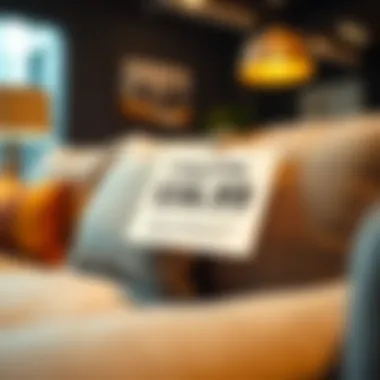Expert Strategies for Selling Your Old Sofa Effectively


Intro
Selling an old sofa isn’t just tossing it onto Craigslist or your local Facebook Marketplace. It’s an art and a science, wrapped in careful preparation and savvy selling strategies. Whether it’s a simple mid-century piece or a lavish sectional, understanding how to present and price your furniture can significantly boost your chances of making a sale. This guide will walk you through the steps, shedding light on the nuances of buyers' preferences and the current marketplace dynamics.
Furniture Styles and Trends
Modern vs. Traditional: Understanding the Aesthetics
Furniture styles are not only about personal taste but also about what’s trending. Modern sofas lean towards clean lines, minimalism, and functionality, while traditional ones offer ornate designs and classic upholstery. When selling, pinpoint the style of your sofa. Is it sleek and contemporary or does it carry the charm of bygone eras? Understanding this will help frame your selling approach.
- Modern sofas: Often have neutral colors, sharp angles, and innovative materials. Think of the popular Scandinavian styles – they are highly sought after.
- Traditional sofas: Typically feature richer colors and elaborate designs, think Chesterfield, and are appreciated for their timeless appeal.
Highlighting the attributes of your sofa that resonate with current buyer trends helps. For modern aesthetics, emphasize its sleekness and practicality. When it comes to traditional designs, nostalgia and craftsmanship are your strong selling points.
Color and Material Trends: What’s In and What’s Out
Colors come and go, but some hues stand the test of time. Currently, jewel tones like emerald green and sapphire blue are striking the right chords in living spaces. In contrast, pastels are retro yet fashionable, perfect for a quirky twist. Likewise, fabric choices affect desirability. Natural fabrics like linen and cotton are favored, while synthetic materials can be hit or miss.
- Current trends:
- Materials:
- Jewel tones: Rich and vibrant, they catch the eye.
- Earthy neutrals: Think taupe and warm grays for a calming experience.
- Fabrics like velvet and leather are gaining traction.
- Sustainability: Eco-friendly materials are attractive for the environmentally conscious consumer.
Assess the color and material of your old sofa. Couple this with an understanding of market preferences and you can better value and promote your furniture.
Furniture Care and Maintenance
Tips for Prolonging the Life of Your Furniture
A sofa’s condition is paramount when selling. A well-maintained piece not only attracts buyers but can potentially inflate your asking price. Here’s how you can keep that sofa looking sharp:
- Regular cleaning: Dust it off frequently, and don’t shy away from a proper vacuum.
- Usage care: Encourage gentle use; coasters for drinks and throws for pet hair are simple habits that make a big difference.
- Preventative measures: Applying fabric protectors can help maintain that fresh-out-of-the-showroom look.
These minor efforts pay off when it’s time to sell. As buyers are more likely to pick a well-cared-for sofa over one that shows signs of wear.
DIY Repair Hacks for Common Furniture Issues
Not every sofa is in mint condition; if yours has some battle scars, don’t despair. There are a few clever ways to patch things up before putting it up for sale:
- For scratches: A bit of wood polish can do wonders for scuffed wooden feet.
- Minor tears: Fabric glue for small rips can salvage the upholstery; just ensure a clean, smooth application.
- Cushion compression: If cushions are flat and sad-looking, consider flipping them or adding some fresh stuffing.
Maintaining and repairing your sofa can make a world of difference in presentation. When a buyer sees a piece that looks well-loved yet cared for, it can sway their decision significantly.
"A well-kept sofa speaks volumes about the home it came from – take the steps necessary to present yours with pride."
By carefully selecting your market approach, enhancing the appeal of your piece through maintenance, and understanding the aesthetic trends, you create a solid foundation for selling your old sofa. It’s about presenting your furniture in the best light possible while meeting the demands of discerning buyers.
Understanding the Value of Your Old Sofa
When you decide to sell your old sofa, grasping its value is crucial. This doesn't merely entail putting a price tag on it; understanding value encompasses much more. Furniture is often a significant financial investment, and recognizing its worth can lead to a smoother selling process, enabling you to maximize returns. Moreover, it helps in building a rapport with potential buyers, who appreciate transparent and knowledgeable sellers.
Assessing the Condition
To start with, assessing the condition of your sofa is paramount. Look for signs of wear and tear. Are there stains, scratches, or structural issues? A sofa that's been well-maintained commands a higher price. You might consider the following points while examining:
- Fabric Quality: Is the upholstery intact or frayed?
- Frame Stability: Does the sofa wobble or creak when weight is applied?
- Comfort Level: How does it feel to sit on it? If it feels like a cloud, it's a plus!
Taking care of minor repairs or thorough cleaning before selling can substantially boost appeal. A little effort can go a long way.
Identifying Brand and Style


Next comes the brand and style. Not all sofas are created equal, and name brands like IKEA, West Elm, or La-Z-Boy generally have a following. These brands often convey quality and trust to buyers. Understand the specific style as well; whether it’s mid-century modern, a sectional, or a recliner, knowing these details can help you market effectively. To get a better grasp, you can:
- Check Labels: Often, the brand and model are included on tags.
- Online Research: Websites like Wikipedia or YouTube provide insights on various furniture styles.
- Consult Locally: Ask your local furniture store for insights into the sofa's brand and value.
These steps allow you to spark conversations and articulate features positively to potential buyers.
Researching Market Demand
Finally, researching market demand is essential. Knowing the current marketplace for second-hand items can guide your pricing strategy. Consult various online avenues, such as local classifieds on Facebook Marketplace or community boards on Reddit. Look at these elements:
- Similar Listings: How are similar sofas priced?
- Local Trends: Are people purchasing more vintage sofas, or do modern styles dominate?
- Timing: Note seasonal trends. Sofas are often in high demand during certain times.
"Always do your due diligence before finalizing the price. Knowledge is power!"
Understanding these facets can set you apart from less informed sellers and allows you to justify your asking price. Keeping an eye on the market can also directly inform your selling approach and allow you to adapt to shifting consumer preferences.
By comprehensively assessing your sofa's condition, identifying its brand and style, and researching market demand, you'll position yourself to sell effectively. These steps not only enhance your knowledge but ultimately bolster the selling process.
Preparing the Sofa for Sale
Selling an old sofa can feel like a daunting task, but prepping it well can make a world of difference in appealing to potential buyers. Before diving into online listings or community boards, it’s essential to give your sofa the attention it deserves. This not only enhances its condition but also presents it in a light that captivates buyers. Thorough preparation is key. It accentuates your sofa’s best qualities while addressing any downsides. Let’s break down the important steps involved in preparing your sofa for sale.
Cleaning and Maintenance Tips
A clean sofa speaks volumes. Dust, stains, and odors can be deal breakers for potential buyers. Start by vacuuming the surface, ensuring to get into those nooks and crannies where crumbs tend to hide. Use an upholstery cleaner suitable for your material. If it’s a fabric sofa, steam cleaning can be particularly effective; just make sure to test a small area first to avoid any mishaps.
For leather sofas, use a gentle leather cleaner followed by a conditioner to maintain its suppleness. Consider this: if your sofa looks good, buyers will feel more inclined to see its value. A dirty sofa says "bargain basement"—but a properly cleaned one? It whispers "investment".
"A clean sofa not only enhances appearance but also builds trust with buyers."
Minor Repairs and Touch-Ups
Now that the sofa is sparkling clean, it’s time to consider any minor repairs. Is there a loose leg? A small tear in the fabric? Tending to these issues can increase the overall desirability of your sofa. Buyers appreciate a piece that looks well-cared-for.
Simple fixes include reattaching legs or screws, sewing minor tears, or even applying fabric glue for fraying edges. It’s also prudent to touch up scratches on wood frames using a matching furniture marker or wax. These modest efforts can elevate your sofa's appeal significantly.
Staging the Sofa for Photos
Once the physical condition is pristine, the next step is staging your sofa for photographs. Photos are often a potential buyer’s first impression. Ensure the space is well-lit, showcasing the sofa's best angles. Natural light works wonders in creating an inviting atmosphere.
Consider adding throw pillows or a cozy blanket to lend a pop of color and warmth. Don’t forget to declutter the surrounding area so the sofa stands out as the focal point. Ideal staging is about creating a scene that helps the buyer envision the sofa in their own space.
By following these steps, you're not just selling a sofa; you're offering potential buyers a glimpse into a comfortable and stylish living area. An appealing photograph combined with a well-maintained sofa can dramatically increase interest and get those inquiries rolling in.
Setting the Right Price
Setting the right price for your old sofa is a crucial step in the selling process. Price isn't just a number; it can make or break a sale. Misjudging the value can lead to leaving money on the table or scaring off potential buyers altogether. When you set the price correctly, it reflects an understanding of your sofa's worth, demand in the market, and shows you are a serious seller. In this section, we'll dissect various elements that contribute to defining the right price for your piece.
Pricing Strategies
Effective pricing strategies are fundamental when selling any item, and your old sofa is no exception. Start by considering the following approaches:
- Cost-Plus Pricing: Add up the original purchase price and any expenses incurred since, like repairs or cleaning, then decide on a profit margin. This method ensures you cover your bases while still giving room for negotiation.
- Competitive Pricing: Scope out the competition. Look at similar sofas being sold online or in local classifieds. If you've got a unique feature, like a custom design or high-quality fabric, you might just have the edge.
- Psychological Pricing: Numbers play tricks on the mind. Setting your price just below a round number (e.g., $299 instead of $300) could make your listing more appealing. People often perceive such prices as better deals.
Utilizing these strategies requires a bit of market savvy and a keen eye for detail. It's about playing your cards right in a way that attracts potential buyers while maximizing your profit.
Considering Market Comparisons
Market comparisons are your best friends when pricing your sofa. Take time to research similar items available for sale. This is where identifying comparable sofas in terms of both brand and condition comes into play. Check sites like Craigslist, OfferUp, and Facebook Marketplace, as well as auction sites like eBay. When analyzing prices, consider:
- Condition: Is your sofa gently used or does it show considerable wear and tear? Be honest in your assessment.
- Brand Recognition: A well-known brand may draw higher prices than lesser-known ones. If your sofa is a high-end brand, it might be worthwhile to highlight that in your listings.
- Trends: Are certain styles or colors in vogue currently? For instance, mid-century modern or neutral hues might fetch a better price in today’s market.
By positioning your price in line with the competition yet recognizing your specific sofa's unique attributes, you help potential buyers see value in your offering.


Negotiation Techniques
Once you’ve anchored your price, be prepared to engage in negotiations with potential buyers. Here, having a flexible mindset can lead to a win-win outcome. Here are a few handy negotiation techniques:
- Start High, But Be Flexible: Begin with a price slightly higher than your minimum acceptable amount and state it confidently. This allows room for negotiation, as many buyers expect to haggle.
- Understand Buyer Psychology: Being able to read a buyer's cues—like interest or hesitation—can empower you in a conversation. If they express doubt, it might be time to sweeten the deal or emphasize unique selling points of the sofa.
- Keep Your Cool: Negotiation can become heated, but it’s important to stay calm and composed. You can entertain offers or walk away if they aren't satisfying. Sometimes, simply stepping back can prompt buyers to reconsider.
In the grand scheme, establishing the right price for your sofa isn’t simply about numbers; it’s about strategy, awareness, and communication. By mastering these aspects, you position yourself not only as a seller but as a savvy negotiator who understands the value they bring to the table.
Choosing the Right Marketplace
When it comes to selling an old sofa, the marketplace you choose can greatly impact how quickly and profitably you make the sale. Finding the right fit involves not just listing your item, but also understanding where your potential buyers are hanging out. Different marketplaces cater to different audiences and selling strategies. Whether you're looking for a quick sale or hoping to get top dollar, having a solid plan for where to sell is essential.
Online Marketplaces
Online platforms have become the go-to option for many sellers. Websites like Craigslist, eBay, and Facebook Marketplace provide wide visibility and ease of use. Here are some benefits:
- Global Reach: You can attract buyers from not just your neighborhood but potentially from other cities.
- User-Friendly: Most online platforms have simple listing processes and support easy communication between buyers and sellers.
- Comparison Shopping: Buyers often check multiple listings, so if your sofa is priced competitively, it can stand out.
- Various Listing Formats: Including swapping or auction styles can caters to different buying preferences.
However, it’s worth remembering that competition can be fierce. To stand out, ensure your sofa is well-presented in photos and your listing description is appealing and informative.
Local Classifieds and Community Boards
While online listings are popular, there are benefits to going local. Community boards or local classifieds like those in newspapers or apps like Nextdoor reach people in your immediate vicinity. The advantages include:
- Less Shipping Hassle: You can avoid the shipping costs and complexities as the buyer comes to pick it up.
- Quick Sales: Local buyers typically prefer immediacy, leading to faster transactions.
- Trust Factor: Meeting face-to-face can enhance trust, making buyers comfortable with their purchase.
To improve your chances of a sale in these spaces, make sure to actively engage with the community. Respond quickly to inquiries and consider lowering your price slightly as a negotiation tactic.
Consignment Shops and Donations
Consignment shops can be a good choice if you prefer a hands-off approach. These stores typically sell items on your behalf, taking a commission from the sale. Benefits include:
- Reduced Workload: They handle the selling process for you, including displaying the sofa and handling customer queries.
- Targeted Buyers: Many consignment shops attract a clientele interested in second-hand goods, increasing your chances of finding the right buyer.
Alternatively, if you're not concerned about making a profit, donations can be a fulfilling way to part with your sofa. Donating often brings a sense of goodwill and clearing out space. Some organizations even offer to pick up your item, adding convenience to the process.
The marketplace you choose can greatly influence your selling experience.
For more elaborate insights on selling techniques and community marketplaces, check out resources from Wikipedia or Reddit.
Keep in mind: A successful selling experience begins with choosing the right marketplace.
Marketing Your Old Sofa
Once you’ve properly assessed, cleaned, and priced your old sofa, it’s time to dive into the realm of marketing. This stage is critical because a well-marketed piece of furniture can fetch a better price and attract more buyers. One might say that marketing is the lifeblood of your selling strategy. Just throwing a sofa on a website and hoping for the best won't cut it; instead, you must craft a narrative that draws potential buyers in.
Key Elements of Marketing Your Sofa:
- Showcase… Not Just Advertise: Besides simply stating what you’re selling, try to paint a picture of how it fits into someone’s home. Picture that sofa cozied up in a stylish living room, surrounded by the right decor.
- Highlight Unique Features: Is the sofa a rare find from a reputable brand? Does it come with a timeless design that speaks to mid-century modern enthusiasts? Make sure to spotlight these elements in your advertising.
- Boost Visibility: The more eyes on your sofa, the better the chance of selling it for your desired price. Use various platforms to cast a wider net.
By employing these marketing tactics, you can greatly increase your sofa's appeal.
Writing Effective Listings
A well-crafted listing is your first chance to impress potential buyers. Think of it like a first date, where you want to show your best side while still being genuine. Here are tips to create that perfect listing:
- Craft a Descriptive Title: Include essential details like brand, style, and condition. For instance, instead of "Old Sofa for Sale," try "Elegant Mid-Century Modern Sofa – Excellent Condition".
- Use Clear Photos: Capture multiple angles in good lighting. Images can often say more than words. Make sure you include close-ups of any distinct features or imperfections.
- Be Honest: Transparency is paramount. If the sofa has a few scuffs or stains, let buyers know upfront. It builds trust and sets realistic expectations.
"The aim of a good listing is to make potential buyers feel like they’re getting a deal that’s too good to pass up."
Utilizing Social Media for Exposure


Social media can be a powerhouse for marketing your sofa beyond classic listing sites. Platforms such as Facebook Marketplace and Instagram can effectively reach diverse audiences. Here's how to make the most of social media:
- Facebook Groups: Join local buy/sell/trade groups. By posting your sofa in these communities, you tap into a hyper-local market.
- Instagram Posts: Share visually appealing images on your profile or story. Use hashtags strategically to boost visibility, such as #UsedFurniture, #SofaForSale, or even geographically relevant tags like #NYCFinds.
- Create an Engaging Story: Narrate the sofa’s history or why you love it. This personal touch can resonate with buyers, making them feel more connected to the item.
Understanding Target Audiences
To sell effectively, it's crucial to know who your potential buyers are. By understanding your audience, you can tailor your marketing efforts accordingly.
- Demographics: Consider age, income levels, and lifestyle choices. For instance, a trendy college student might be looking for a budget-friendly but chic option, while a middle-aged couple may desire something more classic and durable.
- Interests: Perhaps your sofa complements a particular aesthetic, like bohemian or minimalist. By honing in on specific interests, you can place your marketing in the right contexts.
- Feedback and Engagement: After posting, keep an eye on the comments or inquiries. Learning what catches people’s attention can help refine future posts.
Conducting the Sale
Conducting the sale of your old sofa might seem like straightforward task, but it’s packed with nuances that can affect the outcome. This phase is where all the preparation you've done truly comes into play. From the moment you start communicating with potential buyers to making sure the money lands in your pocket, every step is crucial for a smooth transaction.
Communicating with Potential Buyers
Effective communication is the cornerstone of selling. First impressions matter a lot. When a buyer reaches out with an inquiry, prompt and clear replies can set the tone for a positive interaction. Be ready to answer questions about the sofa's condition, size, and any specific features that might appeal to them. It's essential to be transparent; if there’s a tear or a scratch, mention it up front. This honesty can build trust and lead to smoother negotiations.
Using friendly language while being informative can make a significant difference. Rather than a robotic listing response, try to add a personal touch: "Hi there! Thanks for reaching out. The sofa is indeed comfortable, and it was a family piece, so I really value it!" This not only showcases the content of the sofa but also engages potential buyers more effectively. Additionally, sharing the story behind the sofa can make it more enticing, as many buyers appreciate a personal narrative behind an item.
Scheduling Viewings and Deliveries
Once a buyer expresses interest, the next step is arranging a viewing. It’s often best to do this at a time that suits both parties. Be flexible! A buyer may only be available during evenings or weekends. If possible, set up viewing slots where multiple interested buyers can come at once. This not only creates a sense of urgency but also allows you to read multiple interests at a time, which could benefit your negotiations.
As for delivery, the plan can vary. Some buyers might want to pick the sofa up themselves, while others may prefer to have it delivered. If you offer to deliver, clarify any associated costs upfront to prevent misunderstandings later. A straightforward communication will help manage expectations. Remember, being accommodating can sweeten the deal and leave a good impression on the buyer.
Handling Payment Safely
In today’s digital age, plenty of methods exist for handling payments, from cash to apps like PayPal or Venmo. Each has its pros and cons, so knowing how to manage these can save you from potential headaches.
Here are a few tips for ensuring safety while handling transactions:
- Prefer Cash: While it’s not always feasible, cash is immediate and doesn’t leave a paper trail.
- Use Trusted Apps: If you choose to go digital, make sure it’s a reputable platform. Most modern apps have security measures, but they aren’t foolproof.
- Verify Payments: If the buyer is using an app, receive confirmation before handing over the sofa. Wait for the transaction to process fully.
It’s also wise to avoid meeting in secluded places. Instead, choose well-lit and public areas to finalize the sale or ensure your home is comfortable to meet and transact. After all, a smooth conclusion can leave the buyer satisfied, leading to potential recommendations in the future.
Ultimately, conducting the sale effectively can make all the difference in your selling experience. With the right approach, you can turn a simple transaction into a rewarding exchange.
Post-Sale Considerations
Selling your old sofa is not just about the sale itself; it stretches beyond the exchange of goods and cash. It is essential to think about what comes after the dust settles and the transaction is done. This part of the process can greatly affect your future selling successes and relationships with buyers.
Thanking the Buyer and Follow-Up
Once you’ve sold your sofa, it’s a good idea to extend a thank you to the buyer. A simple message—whether it’s a text or even a quick note—can go a long way in establishing goodwill. It shows that you appreciate their business and value their choice. Not only does it create a warm feeling, but it also opens the door for potential future transactions.
Additionally, following up can bring insight into the sale. Ask how they like the sofa and if it fits well in their space. This kind of engagement can yield some valuable feedback, not just about the sofa, but about your selling process overall. Are buyers happy with your responsiveness or the condition of the product? Such reflections can guide improvements for any future furniture selling odysseys.
Assessing Sale Experience
After the sale, take a moment to reflect on how everything unfolded. Ask yourself several questions:
- Did the sofa sell quickly?
- Were buyers responding positively to your listings?
- What questions came up frequently during negotiations?
Armed with answers, consider what went well and what could use improvement. Perhaps it was your pricing strategy that made the difference, or maybe it was the way you showcased the sofa through photographs. If the sofa lingered longer than expected, it could indicate a need to rethink your marketing approach.
Even though you’ve already sold, this introspection is crucial for your growth as a seller. Such evaluations don’t just inform your approach, they shape your entire narrative for any future deals.
Deciding on Future Selling Methods
Having gone through the selling process, you may catch yourself pondering how to tackle your next sale. The experience you’ve just had will serve as a foundation for future endeavors. Do you prefer online platforms over in-person interactions? Was the hassle of logistics worthwhile for the final price you secured?
Consider experimenting with varied approaches:
- Listing on different online platforms—eBay or Facebook Marketplace offer different audiences.
- Exploring consignment shops if you feel it’s worthwhile.
- Donating to a local charity could feel good, even if it means not pocketing cash.
Deciding on methods isn’t merely about moving items; it encapsulates building relationships and understanding the market. Each sofa sold is a stepping stone toward mastering the art of selling furniture.
"A sale is not just an exchange; it’s a narrative about connection and experience."















